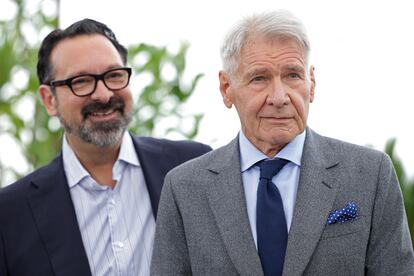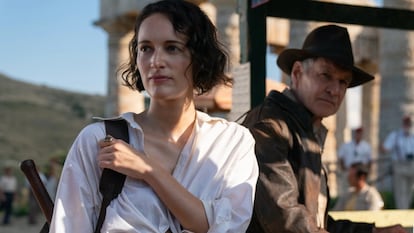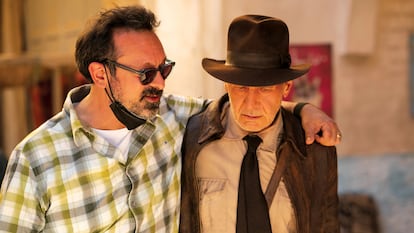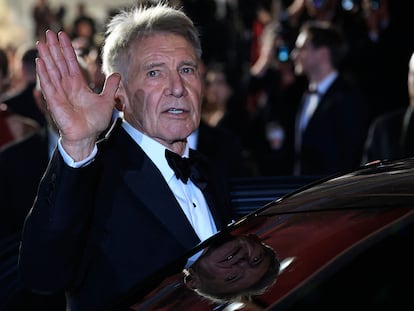Director James Mangold: The latest ‘Indiana Jones’ is ‘a poetic exploration of time’s imprint on life’
Known for high-quality films that also make money, the director concludes 40 years of adventures by the most famous archaeologist in cinematic history


James Mangold’s deep voice resonates with conviction, while his neat-student demeanor exudes tranquility. The New Yorker was tasked with concluding the Indiana Jones story, but he had already done this once before, albeit it on a smaller scale, with Wolverine in Logan (2017). “I’m guilty, yes,” he laughed. “But obviously I had never thought about doing it with Indiana,” he told a group of journalists at the Cannes Film Festival in May, where Indiana Jones and the Dial of Destiny premiered before its release in theaters. The final installment of the Indy saga is scheduled to be released in the United States on June 30.
It wasn’t Steven Spielberg’s idea to have James Mangold as director. After all, the Indiana Jones franchise is his baby. Nor did it come from George Lucas, the creator of the character, or Lucasfilm President, Kathleen Kennedy. It was Harrison Ford who suggested Mangold. In the fall of 2019, Mangold was working with Ford on additional scenes for The Call of the Wild when Ford conveyed some qualms about his digital rejuvenation in the opening sequence of Indiana Jones 5, which takes place at the end of World War II. The technical process wasn’t the problem. Ford was wondering who would want to see a movie with a much older version of Indiana Jones. The details of that conversation were never divulged.
When Spielberg decided not to direct the last chapter of the adventurer-archaeologist saga, Ford proposed Mangold, a director with a track record of commercial success, who is adept at resurrecting careers (Sylvester Stallone in Cop Land) and breathing life into any genre: musical biopics (Walk the Line), westerns (3:10 to Yuma), dramas (Girl, Interrupted), and action films (Knight and Day). Mangold turned Ford Motors’ ambition to win the 1966 Le Mans Grand Prix into the fascinating Ford v Ferrari. At 59 years old, Mangold is synonymous with high-quality films for grownups and knowing how to treat audiences with respect.
But Mangold’s rapport with Spielberg also had something to do with it. “I first met with him [Speilberg] in his office at Amblin [Spielberg’s production company],” said Mangold. “We talked about the structure of the film, and I threw out some raw ideas. I thought, and still think, that the only way to make a fifth film [in the franchise] was to make the hero’s aging a central theme of the movie. It’s somewhat ridiculous how we often try to remain the same person we were decades ago, just like in the movies. I wanted to delve into this theme in the script and challenge the audience with the fact that Indy is old now.” One measure of Mangold’s respect for Spielberg was not asking why he didn’t want to write and direct the final chapter. “Why would I?”

About Harrison Ford, Mangold effusively said, “I adore him. He inspired the whole cast, setting aside the obvious fact that he’s a legend. Harrison is a true actor and has remained at the top for decades because of his ability to explore different worlds and add nuances to his characters.” This begs the question — can the franchise continue with someone else in the lead role? “How could it? The name of the series is Indiana Jones, not Star Wars. There’s literally nothing without Indiana. But that’s just my opinion,” said Mangold diplomatically, adding that he’s only a hired gun.
Nevertheless, Mangold seems to have pointed the way for more installments in the franchise. Together with frequent collaborators John-Henry and Jezz Butterworth, he created the character of Helena, Indy’s dynamic goddaughter played by Phoebe Waller-Bridge (of Fleabag fame), modeled after Barbara Stanwyck’s character in The Lady Eve (1941). The character was created specifically for Waller-Bridge. “She’s charming but can also destroy you,” said Mangold. “One of those magnetic and selfish characters who have always captivated movie audiences — like Han Solo.” Could the Indiana Jones universe live on through Helena? “That’s not up to me,” dodged the filmmaker.

Mangold doesn’t want to make trouble for himself. He has a Swamp Thing movie in development for DC and another for Star Wars. He’s also hoping to direct (if the Writers’ Guild strike allows it) A Complete Unknown, a film about Bob Dylan starring Timothée Chalamet. “I like talking about motivations, scripts, ideas and expectations, but at the end of the day, what draws people into theaters?” asks the director. With a big smile, he answers his own question. “Movie stars. And you can’t ignore that.” Is he wary about working on franchises? “I am alarmed by the idea of being part of one more exploitation of a never-ending tale — the storytelling loses its magic.” How does he challenge that? “Directing is like gambling at a casino. You place your bets and bluff to meet the producers’ expectations. Then you make your move, and if you’re lucky, you win.”
Over the course of five thrilling adventures spanning 42 years, time itself has been a powerful, driving force in the archaeologist’s quest. Rooted in Jones’ search for long-lost relics, these exploits hold a moving lens to humankind’s timeless reflection on mortality and the ultimate futility of our pursuits. “Since that first meeting, we envisioned time as the plot’s foundation to showcase how present actions stem from past mistakes,” said Mangold. It’s fitting that the Antikythera mechanism — a purportedly Archimedean-built computer portrayed as a time machine — serves as the MacGuffin in Indiana Jones 5. “We’re adding a new concept to the film,” explains Mangold. “It delves into a more complex era. Though humans have just set foot on the moon, Nazis are still around in 1969. Rather than presenting the Nazis as the archetypal bad guys, we’ve chosen to challenge the norms and create a world of grays, nuances, nuclear weapons, rock ‘n roll, and realpolitik. Who is the real enemy now? Confusion, instability, and contradictory facts dominate the landscape,” said Mangold. “Indiana Jones, a man with murky depths, pulls off great feats despite long-held fears. He’s egotistical and jealous, a university professor sporting a fedora and a whip. Yet, this human quality is precisely what makes him so relatable. Indiana can falter and persevere through contradiction, which is the essence of life itself. This film is a poetic exploration of time’s imprint on life.”
Sign up for our weekly newsletter to get more English-language news coverage from EL PAÍS USA Edition
Tu suscripción se está usando en otro dispositivo
¿Quieres añadir otro usuario a tu suscripción?
Si continúas leyendo en este dispositivo, no se podrá leer en el otro.
FlechaTu suscripción se está usando en otro dispositivo y solo puedes acceder a EL PAÍS desde un dispositivo a la vez.
Si quieres compartir tu cuenta, cambia tu suscripción a la modalidad Premium, así podrás añadir otro usuario. Cada uno accederá con su propia cuenta de email, lo que os permitirá personalizar vuestra experiencia en EL PAÍS.
¿Tienes una suscripción de empresa? Accede aquí para contratar más cuentas.
En el caso de no saber quién está usando tu cuenta, te recomendamos cambiar tu contraseña aquí.
Si decides continuar compartiendo tu cuenta, este mensaje se mostrará en tu dispositivo y en el de la otra persona que está usando tu cuenta de forma indefinida, afectando a tu experiencia de lectura. Puedes consultar aquí los términos y condiciones de la suscripción digital.
More information
Archived In
Últimas noticias
Welcome to the post-religion era: The idea of Christianity as the absolute truth has become obsolete
‘I thought you would like it’: The risky sexual practice popularized by TV shows and TikTok
The digitalization of tourism: ‘They promise experiences and gave us the worst possible one’
Mexican peso defies uncertainty with forecasts of a new period of stability in 2026
Most viewed
- Sinaloa Cartel war is taking its toll on Los Chapitos
- Oona Chaplin: ‘I told James Cameron that I was living in a treehouse and starting a permaculture project with a friend’
- Reinhard Genzel, Nobel laureate in physics: ‘One-minute videos will never give you the truth’
- Why the price of coffee has skyrocketed: from Brazilian plantations to specialty coffee houses
- Silver prices are going crazy: This is what’s fueling the rally










































